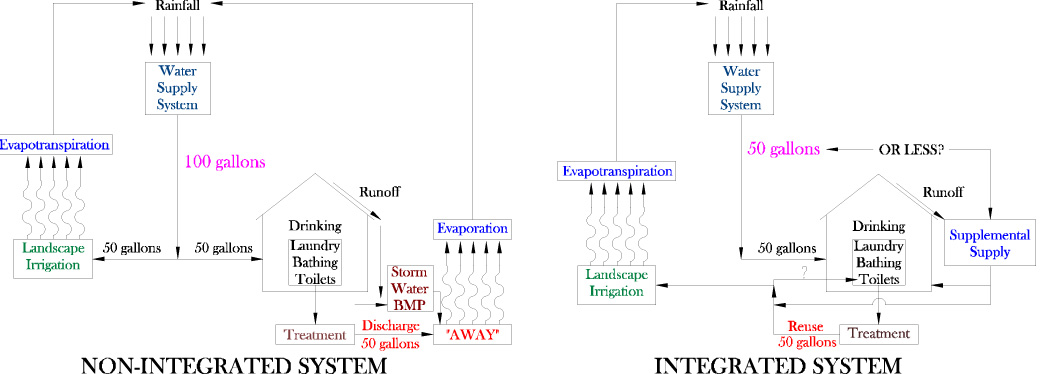

Sustainable water management strategies center on integrating the water supply, stormwater management and “waste” water management functions. Our water resource exists within a closed system – called the hydrologic cycle – but traditional approaches used in residential and commercial developments “silo” the management of each of those functions into totally separate systems – water supply, stormwater, and wastewater. If we are to maximize the efficient and effective use of water, and so maximize sustainability of water resources, our management strategies must recognize that all water exists in the context of this closed system. We must therefore design our management approaches in accord with that understanding – as integrated systems, with the infrastructure that addresses each function being designed as an integrated component of an overall system. The simple schematic below compares a non-integrated – or “silo’d” – system with an integrated management system, illustrating how husbanding of the water resource may be enhanced by “tightening” the water loops.

As this illustrates, to maximize the sustainability of water supplies, these integrated management strategies must also focus on addressing all water as a resource to be husbanded, not as a nuisance to be gotten rid of, to be wasted as expeditiously as possible, which is the focus of conventional stormwater and wastewater management practice. Of course, the water does not “go away” – as noted, the hydrologic cycle is a closed system – but those practices are wasteful in that they expend resources to route the water out of—rather than to maximize its beneficial use within—the immediate environs. Each gallon so wasted is another gallon that must be imported into the project. The most sustainable strategy will maximize the beneficial use of these resources within the project, as much as practical, “tightening up” the loops of the hydrologic cycle, rather than externalizing those resources and then importing water from “traditional” supplies to make up for these wasted resources. Doing this, the developer, the eventual users of the project, and the community-at-large will realize fiscal, societal, and environmental benefits.
This web site explores this integrated water resources management strategy and its component parts – the decentralized concept of “waste” water management, low-impact development stormwater management, and rainwater harvesting as water supply strategy.